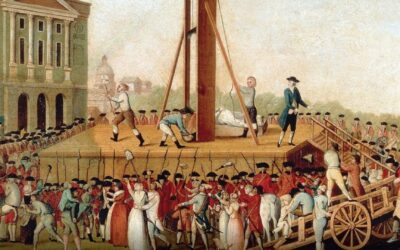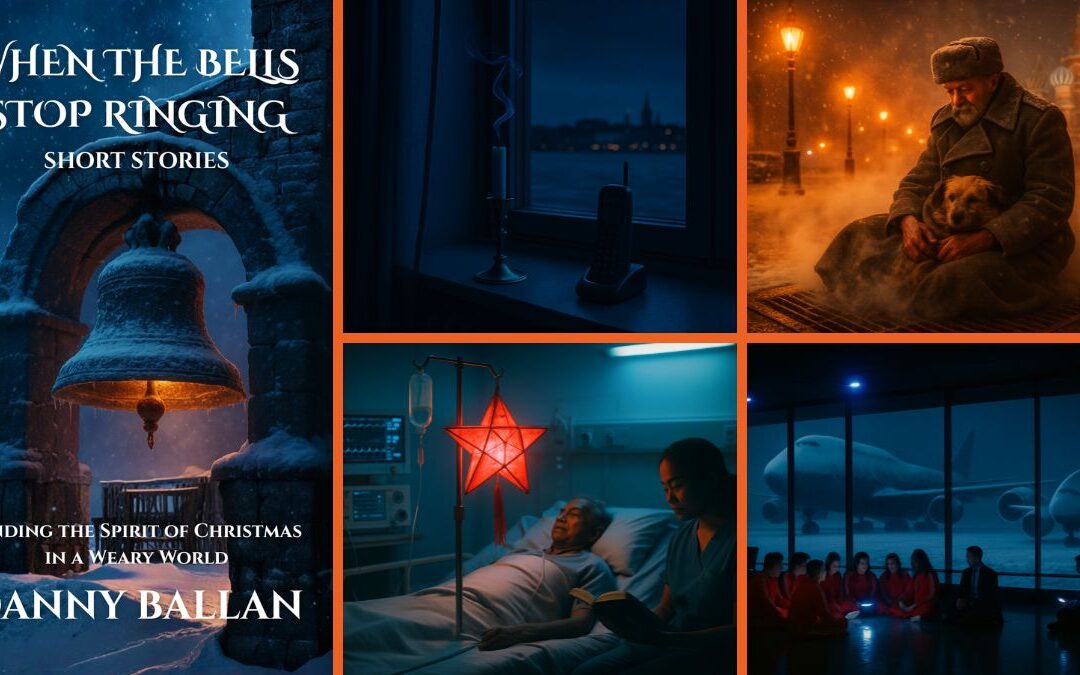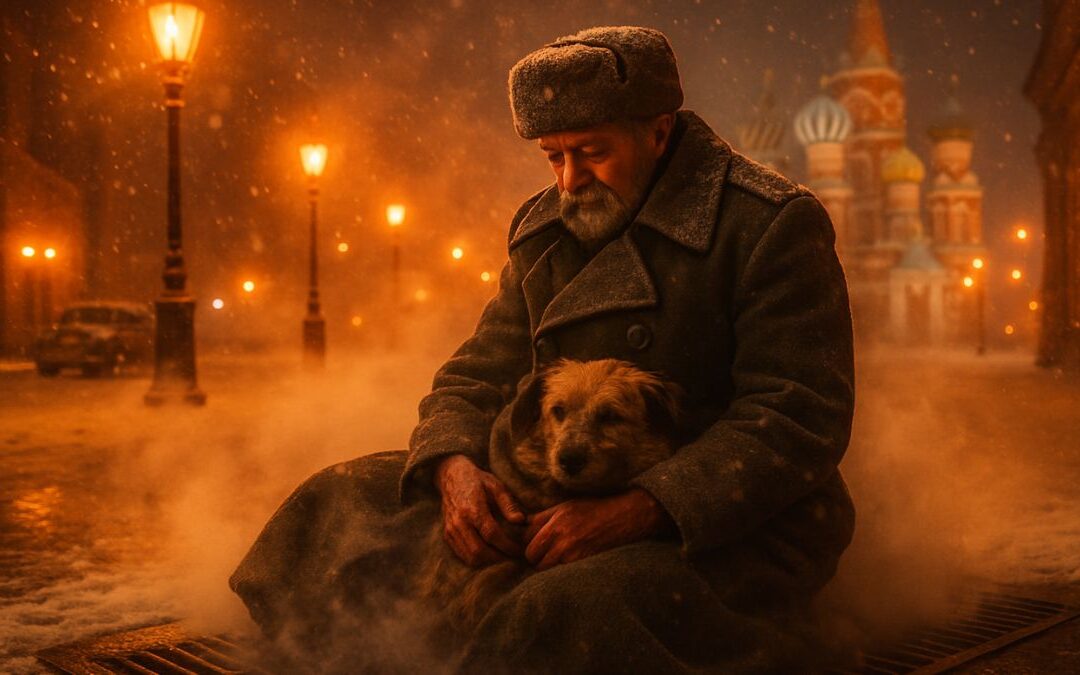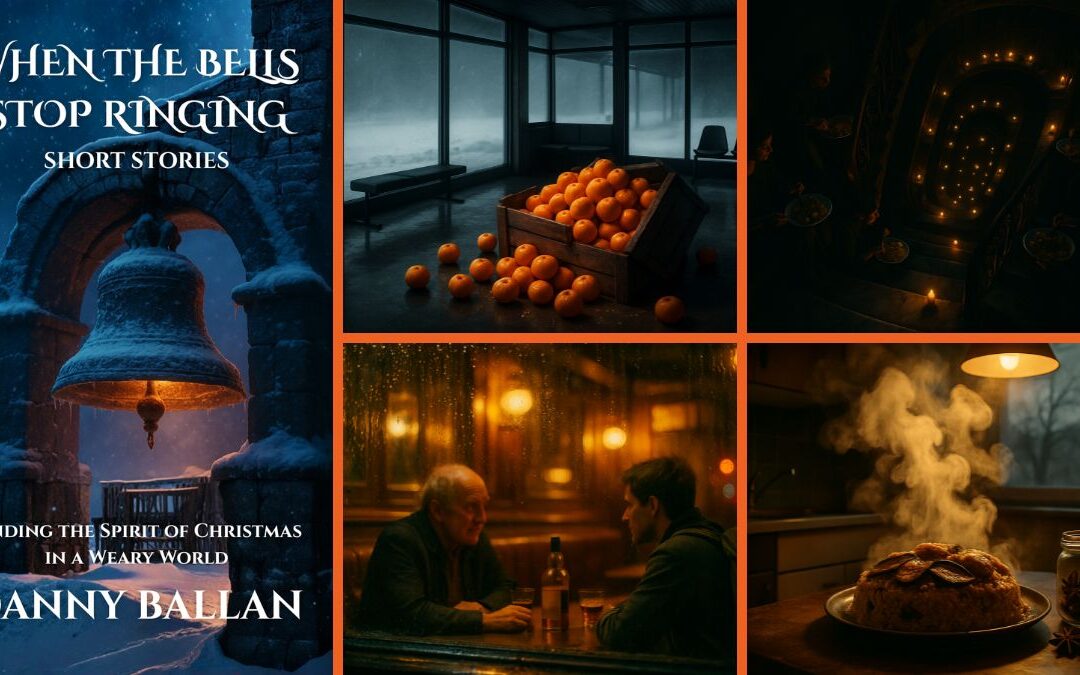Introduction
Learn about an immortal classic by Emily Bronte. In this episode of Let’s Talk Literature, we will talk about Wuthering Heights. We will discuss its plot, characters and themes.
Audio Episode
Interactive Transcript
Text Transcript
Let’s Talk Literature | Wuthering Heights by Emily Bronte
Danny:
Welcome to a new episode from English Plus Podcast. I’m very happy to welcome you to the first of our Let’s Talk Literature episode series. In this series of weekly episodes, we will focus on a topic from literature, an author, a period or a single book, like we’re going to do today. In this episode, we’re going to discuss in detail an immortal book from the 19th century. We’re going to talk about Wuthering Heights by Emily Bronte. We will talk about the storyline, the characters and the themes in this book. Although, there are going to be some spoilers for those of you who haven’t read the book yet, but I assure you, even if I read the entire book to you, it’s still worth taking the time to read it yourself. It’s one of those books you really want to read before you die.
Now, before we start, let me remind you that there’s a wealth of learning opportunities on our website englishpluspodcast.com so after you finish listening to this episode, take the time to go to our website and browse it, and I guarantee you will find something to your liking, something both interesting and useful.
And now without further ado, let’s start with our brand-new Let’s Talk Literature episode and talk about Wuthering Heights.
Today, I have Ben with me to discuss this great book. Welcome to the show, Ben.
Ben:
Thank you, Danny. I’m so glad to be a part of this new Let’s Talk Literature series.
Danny:
Some people say literature is dead, or to say the least, it’s an old-fashioned interest that is probably going to fade away in the near future. While I can’t agree to that because I am a writer myself, what do you say to people who believe literature has become a useless human endeavor?
Ben:
Literature is not dead, it is still alive and has a significant impact on society. It allows people to express their thoughts and emotions, explore new ideas, and gain new perspectives. Literature also helps to preserve cultural heritage and provides a historical record of human experience. Furthermore, it is an essential tool for education and personal growth. People who believe that literature has become a useless human endeavor are likely not aware of its ongoing relevance and importance.
Danny:
So, do you believe it’s still important to read and study works of literature?
Ben:
Yes, I do. Reading and studying works of literature is important because it helps people develop a deeper understanding of themselves and the world around them. It also helps to improve critical thinking skills, empathy, and imagination. By exposing people to different cultures, perspectives, and experiences, literature promotes cultural literacy and encourages open-mindedness. In addition, literature is a valuable source of entertainment and can bring joy and escape from the daily routine. So, reading and studying works of literature remains a valuable and worthwhile endeavor.
Danny:
Alright, let’s focus on a specific work of literature today. We will talk about Wuthering Heights by Emily Bronte. Let’s start by talking about Emily Bronte herself. What can you tell me about her?
Ben:
Emily Bronte was an English novelist and poet born in 1818. She was the youngest of six children and grew up in a family with a strong literary background. Emily’s father was a priest and her mother was a homemaker who encouraged her children’s creativity. Emily, along with her siblings Charlotte, Branwell, Anne, and Patrick, created a rich imaginative world in their childhood, and their works have been widely recognized and celebrated.
Emily’s only novel, “Wuthering Heights,” was published in 1847 under the pseudonym “Ellis Bell.” The book was received with mixed reviews upon its initial publication but has since become regarded as a classic of English literature. The novel is notable for its unconventional narrative structure, complex characters, and vivid descriptions of the natural world. Emily Bronte died at the young age of 30 in 1848.
Danny:
Why did Emily publish Wuthering Heights under a pseudonym?
Ben:
Emily Bronte chose to publish “Wuthering Heights” under a pseudonym, “Ellis Bell,” because of the societal norms and expectations of the time. Women writers were often not taken seriously and were expected to stick to certain genres, such as romance and domestic fiction, that were considered suitable for their gender. The Bronte sisters, including Emily, chose to use pseudonyms as a way to protect their identities and to avoid gender bias in the literary world. The use of a pseudonym also allowed them to be more daring in their writing and to push against the constraints of conventional gender roles. The Bronte sisters’ use of pseudonyms, and the success of their works, paved the way for future female writers and challenged societal norms about women and writing.
Danny:
Can you tell me a little more about the historical background of the time Emily wrote her immortal book, so we may better understand the themes present in the book?
Ben:
The historical background during the time when Emily Bronte wrote “Wuthering Heights” was the early 19th century England, a time of great social, economic, and political change. The Industrial Revolution had transformed the country, bringing new wealth to some but also poverty and hardship to others. The working class was struggling, and there was a growing divide between the rich and the poor.
At the same time, there were changes in the status of women in society. The idea of women’s rights was gaining traction, and there was a growing recognition of the importance of women’s education. However, despite these advances, women still faced significant obstacles and were largely excluded from many areas of public life.
These historical factors influenced the themes present in “Wuthering Heights.” The novel explores the struggle for power and control, the relationship between classes, and the limitations faced by women. It also reflects on the impact of the Industrial Revolution on rural life and the changing social dynamics of the time. The characters in the novel are complex and often flawed, reflecting the realities of life in 19th-century England. Overall, the historical background provides a rich context for understanding the themes and characters in “Wuthering Heights.”
Danny:
What makes Wuthering Heights a great novel?
Ben:
“Wuthering Heights” is considered a great novel for several reasons:
Character development: The characters in the novel are complex and multi-dimensional, with their own motivations, desires, and flaws. They are also memorable and enduring, making a lasting impression on readers.
Narrative style: The novel’s unconventional narrative style, which moves between different narrators and time periods, adds to its complexity and richness.
Themes: The novel explores universal themes of love, obsession, revenge, and the consequences of societal and personal choices. These themes are timeless and still resonate with readers today.
Setting: The bleak and wild setting of the Yorkshire moors provides a vivid backdrop for the events of the novel and adds to its sense of atmosphere and foreboding.
Writing style: Emily Bronte’s writing style is powerful, evocative, and filled with vivid descriptions of nature and human emotions. Her writing style has been widely praised for its originality and beauty.
Overall, the combination of these elements makes “Wuthering Heights” a timeless classic that continues to captivate and move readers today.
Danny:
Alright. Let’s dig in a little deeper into the novel’s storyline. What’s Wuthering Heights about in brief?
Ben:
“Wuthering Heights” is a novel about the intense and tempestuous relationship between Heathcliff and Catherine Earnshaw, and the events that occur as a result of their love. The story is set on the Yorkshire moors in northern England, and begins with the arrival of Mr Lockwood, a tenant, at Wuthering Heights, the estate of his landlord, Heathcliff. Through his interactions with Heathcliff and the other residents of Wuthering Heights, Mr Lockwood learns about the troubled history of the estate, including the passionate and destructive love between Heathcliff and Catherine.
As the story unfolds, we learn about Heathcliff’s rise from a poor orphan to a wealthy and powerful landowner, and about his turbulent relationship with Catherine, who marries another man despite her deep love for Heathcliff. The consequences of their love play out over several generations, causing pain and suffering for many of the characters. The novel ultimately explores themes of revenge, obsession, and the enduring power of love, and raises questions about the meaning of human existence and the nature of good and evil.
Danny:
Let’s talk a little more about how Heathcliff was introduced into the Earnshaw’s household as a member of their family.
Ben:
Heathcliff was introduced into the Earnshaw family as a foundling or an orphan. Mr Earnshaw, the father of the family, brings him back from a trip to Liverpool and takes him into the family as a son, much to the disapproval of his wife and children, Hindley and Catherine. Despite their initial resistance, Catherine and Heathcliff quickly form a strong bond and become close childhood companions. Over time, their relationship deepens and becomes more complex, until it ultimately becomes a passionate and all-consuming love. This love is the central conflict of the novel and drives many of the events that occur throughout the story.
Danny:
Can we say that Catherine and Heathcliff enjoyed a happy childhood together?
Ben:
It is debatable whether Catherine and Heathcliff enjoyed a happy childhood together. While they were close childhood companions, their relationship was not without difficulties and challenges. They both came from different social classes, with Catherine being born into a wealthy family and Heathcliff being an outsider and an orphan. This created conflicts and tensions between them, especially as they grew older and became more aware of the societal expectations placed upon them.
Additionally, their relationship was complicated by the fact that Catherine was betrothed to another man, Edgar Linton, and Heathcliff’s feelings for her were not reciprocated in the way he wanted. Despite these difficulties, Catherine and Heathcliff’s love for each other was intense and passionate, and they remained close throughout their lives. Whether this constitutes a happy childhood is a matter of interpretation, but it is clear that their relationship was both complicated and deeply meaningful to both of them.
Danny:
When did Heathcliff problems start?
Ben:
Heathcliff’s problems can be traced back to his introduction into the Earnshaw family as an orphan and the difficulties he faced as a result of his lower social status. He was often mistreated by Hindley, Catherine’s brother, and faced discrimination and rejection from others in the community because of his background.
However, Heathcliff’s problems really escalate when Catherine marries Edgar Linton, despite her deep love for Heathcliff. This rejection causes Heathcliff to leave Wuthering Heights and become wealthy through unknown means. When he returns, he seeks revenge against those who have wronged him, including Hindley and the Linton family. Heathcliff’s thirst for revenge and his intense love for Catherine drive much of the conflict in the novel, causing pain and suffering for many of the characters. Ultimately, Heathcliff’s problems stem from his intense emotions and the deep sense of injustice he feels, which drive his actions throughout the story.
Danny:
Why did Catherine marry Edgar while she was obviously in love with Heathcliff?
Ben:
Catherine marries Edgar Linton for several reasons, despite her obvious love for Heathcliff. One reason is social class. Catherine comes from a wealthy family and is expected to marry someone of a similar social status. Edgar is a wealthy gentleman, while Heathcliff is an outsider and a foundling, which makes him an unacceptable match in the eyes of Catherine’s family and society.
Additionally, Catherine’s experiences with Heathcliff’s anger and violence likely influenced her decision to marry Edgar. She may have believed that a marriage to Edgar would provide her with a more stable and peaceful life. Finally, Catherine’s own conflicting feelings may have played a role in her decision to marry Edgar. She loves Heathcliff deeply, but also fears him and is torn between her desire for a secure and stable life with Edgar and her deep love for Heathcliff.
In the end, Catherine’s decision to marry Edgar has profound and far-reaching consequences for both her and Heathcliff, as well as for the other characters in the novel. It drives much of the conflict and sets the stage for the intense and passionate love affair that forms the core of the story.
Danny:
So, what prompted Heathcliff to leave?
Ben:
Heathcliff leaves after Catherine marries Edgar Linton, and he realizes that his love for her will never be reciprocated. Heathcliff is deeply hurt and angry when Catherine chooses to marry Edgar, and he feels rejected and betrayed by her. This rejection drives Heathcliff to leave Wuthering Heights and pursue wealth and power in order to gain the means to seek revenge against those who have wronged him.
During his absence, Heathcliff becomes wealthy and returns to Wuthering Heights, where he begins his campaign of revenge against Hindley, the Linton family, and others who have crossed him. He uses his newfound wealth and power to manipulate and torment the other characters, and his actions drive much of the conflict in the latter half of the novel. Ultimately, Heathcliff’s departure is a turning point in the story and sets the stage for his intense and passionate love affair with Catherine and his quest for revenge.
Danny:
How did Heathcliff exact his revenge on the Earnshaws and the Lintons?
Ben:
Heathcliff exacts his revenge on the Earnshaws and the Lintons through a series of cruel and manipulative actions. He begins by tormenting Hindley, Catherine’s brother, who had mistreated him when they were children. He takes control of Wuthering Heights and forces Hindley into debt and alcoholism, leading to Hindley’s eventual death.
He also marries Isabella Linton, Edgar’s sister, in order to gain access to the Linton family’s wealth and status. He then mistreats and oppresses Isabella, causing her to run away from Wuthering Heights. He also manipulates the inheritance of Cathy, the daughter of Catherine and Edgar, in order to ensure that she will marry his son, Linton, and secure the continuity of his power and influence.
Throughout the novel, Heathcliff uses his wealth, power, and cunning to manipulate and torment the other characters, causing them great pain and suffering. He is driven by his intense love for Catherine and his deep sense of injustice and rejection, which fuels his desire for revenge. Ultimately, Heathcliff’s actions serve as a powerful commentary on the destructive effects of love, obsession, and revenge, and they drive much of the conflict and tension in the novel.
Danny:
Why didn’t Catherine return to Heathcliff when he came back as we, again, can see she was still in love with him? And how would that affect the story if it ever happened?
Ben:
Catherine doesn’t return to Heathcliff when he comes back because she is torn between her love for him and her sense of duty and obligation to her family. Catherine recognizes the depth and intensity of her feelings for Heathcliff, but she is also aware of the social and moral conventions of her time, which dictate that she must marry someone of her own social class.
When Heathcliff returns, Catherine is already married to Edgar and is the mother of their daughter, Cathy. She feels trapped in her marriage and is torn between her loyalty to her family and her love for Heathcliff. Her death soon after Heathcliff’s return only deepens the tragedy of their relationship, as it reinforces the idea that their love was forbidden and doomed from the start.
If Catherine had returned to Heathcliff, the story would likely have taken a very different turn. Their reunion could have led to a resolution of the conflict and tension between them and the other characters, and it might have allowed Heathcliff to put aside his obsession with revenge. However, the intense and passionate nature of their relationship would likely have caused other problems and challenges, as they struggled to navigate the social and moral expectations of their time. Ultimately, the idea of Catherine returning to Heathcliff raises important questions about the nature of love, loyalty, and social convention, and it adds a layer of complexity and uncertainty to the story.
Danny:
So, we know that Catherine never returned to Heathcliff, and she actually died soon after Heathcliff returned. How did her death affect Heathcliff?
Ben:
Catherine’s death has a profound and lasting impact on Heathcliff. It represents the loss of the only person who truly understood and loved him, and it marks the end of any hope of a future with her. Heathcliff is consumed by grief and anger, and he becomes even more vengeful and cruel in his actions towards the other characters.
Heathcliff’s obsession with Catherine even after her death is a central theme in the novel, and it serves to underscore the intensity and power of their love. He refuses to accept her death, and he spends much of the rest of the story seeking to reunite with her in some way. This is reflected in his erratic and often cruel behavior, as he torments the other characters and manipulates them in an attempt to assert his power and control over them.
Ultimately, Heathcliff’s reaction to Catherine’s death highlights the destructive effects of unrequited love and the pain and suffering that it can cause. It serves as a powerful commentary on the nature of loss and grief, and it adds a layer of tragedy and darkness to the overall story of Wuthering Heights.
Danny:
Is there a silver lining at the end of the story of Wuthering Heights, or is it all about loss and tragedy?
Ben:
Wuthering Heights is a dark and intense story, and it is characterized by themes of loss, tragedy, and the destructive power of unrequited love. However, it is also a story of redemption and the power of love to endure even in the face of adversity.
At the end of the story, the younger generation of Cathy and Hareton find love and happiness together, despite the obstacles and hardships they have faced. Their love represents a glimmer of hope in an otherwise dark and tragic story, and it serves to show that even in the midst of tragedy, it is possible for love to endure and for happiness to be found.
It is important to note that the conclusion of the story is not a conventional happy ending, and it does not resolve all of the conflicts and issues raised throughout the novel. However, it does offer a sense of closure and a glimmer of hope, and it suggests that the love and relationships forged throughout the story will endure and continue to shape the lives of the characters even after the events of the novel have come to a close.
Danny:
Alright, now let’s analyze the main characters in the story before we finish with some discussion questions about it. Let’s start with the character of Heathcliff.
Ben:
Heathcliff is the central figure in Wuthering Heights, and he is widely regarded as one of literature’s most complex and enigmatic characters. Heathcliff is introduced as an orphan who is taken in by the Earnshaw family, and he quickly becomes close friends with Catherine. As they grow up together, they develop a deep and intense love for each other, but their relationship is ultimately thwarted by societal expectations and Catherine’s eventual marriage to Edgar Linton.
Heathcliff is driven by a powerful and obsessive love for Catherine, and this love consumes him throughout the novel. He is portrayed as a dark, brooding, and vengeful figure, and he embarks on a campaign of revenge against the other characters in the novel after Catherine’s death. However, his love for Catherine is also the driving force behind much of his behavior, and it serves to highlight the power of love to shape and motivate human behavior.
Throughout the novel, Heathcliff is depicted as a complex and contradictory figure, capable of great cruelty and violence, but also of deep passion and intense love. He is often seen as embodying the themes of the novel, including the destructive power of unrequited love and the cyclical nature of revenge and violence. Heathcliff remains one of the most memorable characters in the literary canon, and his story continues to captivate and inspire readers today.
Danny:
What about Catherine Earnshaw?
Ben:
Catherine Earnshaw is the female protagonist of Wuthering Heights and one of the central figures in the novel. She is depicted as a complex, strong-willed, and passionate young woman, and her relationship with Heathcliff serves as the driving force behind much of the novel’s action.
Catherine is raised alongside Heathcliff and the two develop a close and intense bond from a young age. As they grow older, Catherine finds herself torn between her love for Heathcliff and her desire for social mobility and financial security, which she believes can only be achieved through marriage to Edgar Linton. Despite her love for Heathcliff, she eventually marries Edgar, setting off a chain of events that has profound consequences for both her and Heathcliff.
Throughout the novel, Catherine is depicted as a dynamic and influential figure, and her actions and decisions shape the lives of the other characters in the novel. Her love for Heathcliff and her struggle to reconcile this with her desire for social status and security is a central theme of the novel, and her story serves to highlight the power of love and the social, cultural, and economic forces that can shape human relationships. Despite her flaws and limitations, Catherine remains a memorable and captivating character, and her story continues to resonate with readers today.
Danny:
And what about Edgar Linton?
Ben:
Edgar Linton is a central character in Wuthering Heights and serves as a foil to Heathcliff. He is depicted as a gentle, wealthy, and well-educated young man, and his marriage to Catherine Earnshaw sets in motion many of the events of the novel.
Edgar is depicted as a kind and considerate husband to Catherine, but he is ultimately unable to compete with Heathcliff for her affections. Throughout the novel, Edgar is portrayed as passive, idealistic, and somewhat naive, in contrast to Heathcliff’s brooding, vengeful, and tempestuous personality.
Despite his limitations, Edgar serves as an important contrast to Heathcliff, and his story helps to highlight the themes of love, loss, and social class that are central to the novel. Edgar’s struggle to understand and win Catherine’s affections, and his ultimate failure to do so, serves to underscore the power of love and the role that social, cultural, and economic factors play in shaping human relationships. Through his character and actions, Edgar offers a valuable perspective on the themes and issues explored in Wuthering Heights.
Danny:
And finally, what about the younger generation, Cathy Linton and Hareton Earnshaw?
Ben:
Cathy Linton and Hareton Earnshaw are the younger generation in Wuthering Heights, and their relationship is one of the key elements of the novel’s resolution. Cathy is the daughter of Catherine and Edgar, and Hareton is the son of Hindley.
Cathy and Hareton’s relationship serves as a counterpoint to the troubled relationship between Heathcliff and Catherine, and it represents a second chance for love and happiness. Cathy and Hareton are initially portrayed as strong-willed and proud, but as the novel progresses, they each learn to soften their hearts and develop affection for each other.
Their relationship serves as a symbol of hope and renewal, and it suggests that the cycle of hatred and violence that has plagued the families of Wuthering Heights may eventually come to an end. Through Cathy and Hareton’s relationship, Emily Bronte explores themes of growth, transformation, and the power of love to heal even the deepest wounds.
In this sense, Cathy and Hareton represent a new generation of characters, one that is free from the bitterness and anger that has dominated the lives of the previous generation, and that offers a glimmer of hope for a brighter future.
Danny:
Now that we have talked about the main characters in the novel, let’s get a little more literary and talk about the narrative structure of Wuthering Heights?
Ben:
Wuthering Heights is a novel that features a complex and unconventional narrative structure. The novel is divided into two parts, with the first part told primarily from the point of view of Nelly Dean, and the second part told primarily from the point of view of Lockwood. This multiple point of view approach allows the author to explore the events of the story from multiple perspectives, and to create a rich and nuanced understanding of the motivations and emotions of the characters.
Another notable aspect of the narrative structure of Wuthering Heights is its use of flashbacks. Throughout the novel, Nelly and Lockwood both reflect on past events, which are then related to the reader. This structure allows the author to delve into the backstories of the characters and to explore the relationships and conflicts that have shaped their lives.
Additionally, the narrative structure of Wuthering Heights is characterized by its use of contrasts and parallels. For example, the relationships between Heathcliff and Catherine, and between Cathy and Hareton are similar in many ways, yet they are also fundamentally different. The narrative structure of the novel reflects this contrast, and it underscores the idea that while the past may shape the present, it does not determine it.
Overall, the narrative structure of Wuthering Heights is an integral part of the novel’s themes and its impact on readers. Through its multiple points of view, flashbacks, and contrasts, the novel creates a rich and nuanced understanding of its characters and the world in which they live.
Danny:
Maybe, we should also talk about the class structure in the novel as it is indeed a crucial piece of the puzzle to learn about if we want to understand the story. What can you tell me about that?
Ben:
Wuthering Heights portrays the struggle between two contrasting social classes – the wealthy landed gentry represented by the Lintons and the working-class represented by Heathcliff. The characters are often in conflict because of their social status and struggle for power and control. Heathcliff, who rises from poverty to wealth, seeks revenge against the upper-class society that once rejected him. The class struggles are an integral part of the novel, serving as a backdrop to the central themes of love, revenge, and class mobility.
Danny:
Let’s add to this background and talk about the class structure in the Victorian Era.
Ben:
The Victorian Era (1837-1901) was a time of great social and economic change in England, marked by rapid industrialization, urbanization, and rising wealth inequality. The social structure of the time was heavily hierarchical, with the monarchy at the top and the working class at the bottom. The middle class, including the gentry, was growing in size and influence, while the working class faced widespread poverty and poor working conditions. These social, economic and political divisions were reflected in literature of the time, including in Wuthering Heights, where the struggles between the upper and lower classes are an important aspect of the story.
Danny:
Alright, now let’s focus on some major themes in Wuthering Heights. What about the nature of love in Wuthering Heights?
Ben:
The theme of love in Wuthering Heights is complex and multifaceted. On one hand, there is the passionate, all-consuming love between Catherine and Heathcliff, which defies societal conventions and boundaries. On the other hand, there is the more conventional, respectable love between Catherine and Edgar, which is motivated by social status and security. The novel also explores the power dynamics of love, as well as the destructive consequences that can result from it. Ultimately, Wuthering Heights raises questions about the true nature of love and whether it can bring happiness or bring destruction.
Danny:
Why was the love between Catherine and Heathcliff so different from the love between everybody else, especially in that era?
Ben:
The love between Catherine and Heathcliff is different from other forms of love in the novel because it is born out of a deep, intense bond formed during their childhood together. Unlike the more conventional forms of love in the novel, which are often motivated by societal norms and expectations, the love between Catherine and Heathcliff is intense, wild and uncontainable. This makes it stand in stark contrast to the more restrained, polite forms of love that are prevalent in the society depicted in the novel. It is also a love that transcends societal boundaries, as Heathcliff is not a member of Catherine’s social class and is treated as an outsider by the rest of the characters. This makes the love between Catherine and Heathcliff all the more powerful and all the more taboo in the context of the era in which the novel was written.
Danny:
In the novel, we see a lot the contrast between the capacity for love and the ability to hate. What can you tell me about that?
Ben:
In Wuthering Heights, love and hate are intertwined and often displayed by the same characters. The passion and intensity of the characters’ love for each other is matched by their capacity for revenge and hate, especially in Heathcliff’s case. This theme is emphasized through the destructive nature of the relationships in the novel and the consequences of such intense emotions. The story highlights the danger of allowing emotions to consume and control one’s actions, leading to a cycle of revenge and suffering.
Danny:
And now, let’s talk about Heathcliff’s obsession, and why it was so?
Ben:
In Wuthering Heights, Heathcliff is depicted as a character consumed by an all-consuming obsession. His love for Catherine is so intense and absolute that it transforms into a destructive force, driving him to seek revenge on those who have wronged him, especially Hindley and Edgar. His obsession is fueled by a combination of anger, hurt, and a desire for justice and a sense of entitlement to Catherine’s love. Heathcliff’s obsession is seen as a destructive force throughout the novel and is a major theme, highlighting the dangers of unchecked emotions and the consequences of obsession.
Danny:
Alright, I have a couple of more questions to ask you before we wrap up our discussion about Wuthering Heights. Throughout the novel, we find ourselves in Wuthering Heights or Thrushcross Grange; How can we compare and contrast Wuthering Heights and Thrushcross Grange?
Ben:
Wuthering Heights and Thrushcross Grange represent two contrasting ways of life and two conflicting values in the novel. Wuthering Heights symbolizes wildness, passion, and a more natural way of life, while Thrushcross Grange represents civilization, order, and propriety. The two estates also reflect different attitudes towards wealth, power, and social status, with Thrushcross Grange being a symbol of wealth and status, while Wuthering Heights is portrayed as a place of poverty and struggle. This contrast is used to explore the themes of class and the dangers of excessive materialism, as well as the idea that true happiness cannot be found in material wealth.
Danny:
Now, I have a question related to the variety of points of view used in the novel. Although Nelly and Lockwood are the primary narrators, other characters get to narrate a chapter or two, though Edgar does not. What effect does the lack of insight into his character’s point of view have on Wuthering Heights?
Ben:
The lack of insight into Edgar’s point of view creates a one-dimensional portrayal of him and contributes to his portrayal as a passive and unimposing character compared to the more complex characters of Catherine and Heathcliff. It also highlights the themes of the novel, such as the struggle for power and control, as Edgar is portrayed as being controlled by his circumstances and societal expectations, rather than actively shaping his own destiny.
Danny:
What about the role of the supernatural? What role does the supernatural play in Wuthering Heights?
Ben:
The supernatural elements in Wuthering Heights are primarily used to reflect the intense emotions and the sense of hauntedness that pervade the novel. For example, Catherine’s ghost is said to haunt Wuthering Heights and Thrushcross Grange, and Heathcliff is described as being “possessed” by his passion for her. These elements serve to reinforce the sense of intense passion and longing that drives the characters in the novel. Additionally, the supernatural elements contribute to the sense of foreboding and doom that permeates the story.
Danny:
What about the pairs or dualities we find in Wuthering Heights? A multitude of ordered pairs exist throughout the text. What are the most significant dualities? What does Bronte gain by creating symmetry between generations? And What does she lose?
Ben:
In Wuthering Heights, several ordered pairs or dualities exist throughout the text. Some of the most significant ones are: Heathcliff and Haerton, Catherine and Cathy, Thrushcross Grange and Wuthering Heights, and civilization and the wild. These dualities create symmetry between generations, emphasizing the cyclical nature of the characters’ experiences and emotions. By creating these pairs, Bronte underscores the themes of love, class, and societal expectations, as well as the destructive effects of revenge and obsession. However, by focusing on these dualities, Bronte may also lose some of the complexity and individuality of her characters.
Danny:
And now that we have discussed Wuthering Heights in detail. Why do you think it’s a great book to read?
Ben:
Wuthering Heights is considered a great book to read for several reasons. Firstly, it is a novel that explores complex human emotions and relationships. Secondly, it uses the setting and the contrast between Wuthering Heights and Thrushcross Grange to create a vivid atmosphere and highlight class differences. Thirdly, its exploration of the theme of love and obsession adds depth and complexity to the story. Fourthly, its narrative structure, with multiple narrators, adds to the unpredictability of the plot and the reader’s engagement. Lastly, its rich imagery and vivid descriptions, especially of the natural setting, make it a timeless classic that continues to captivate audiences.
Danny:
I guess that will be all about our discussion of Wuthering Heights. Thank you very much for sharing your input and knowledge of this great novel, Ben.
Ben:
You’re welcome! I’m glad I could help.
Danny:
And a big thanks for our listeners. Thank you very much for listening to another episode from English Plus Podcast. We hope you enjoyed our brand-new Let’s Talk Literature. We’ll meet again with other episodes. Don’t forget to check out our website englishpluspodcast.com for more learning and fun. This is your host, Danny. Thank you very much for listening. I will see you next time.










Well_structured and informative without being pedantic. Love the question and answer style. Excellent. Will tune in again. PS: I’m a new-comer.
Thank you Janet. I’m glad you liked the post. I’m honored to welcome you to English Plus, and I definitely hope to see you again on the website.